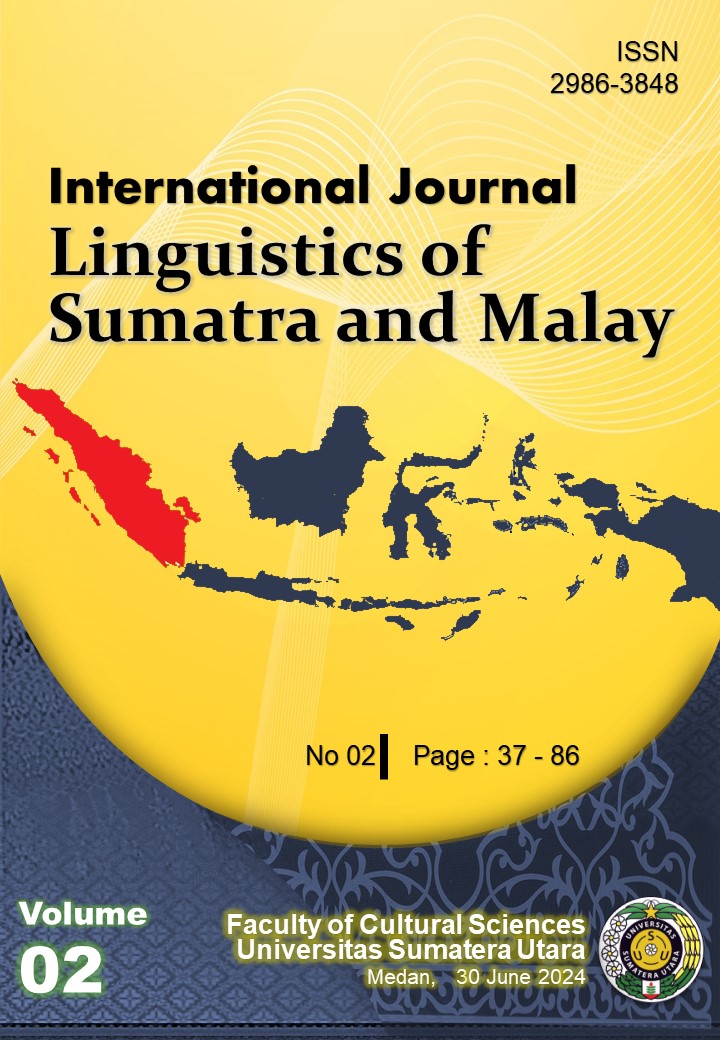The Conjunctions "Sebab" and "Karena" in the Minangkabau Language Variety: A Corpus-Based Syntactic Study
DOI:
https://doi.org/10.32734/ijlsm.v2i2.17134Keywords:
Conjunction, Frequency, Colligation, Syntactic Role, CorpusAbstract
This study aims to analyze the frequency, colligation pattern, and syntactic role of "karena" and "sebab" conjunctions in the MinangKabau language variety. The Minang LCC corpus of the Corpus Query Processor (CQPweb) gadget was used to obtain data. There are two phases of analysis in this research: quantitative analysis and qualitative analysis. The frequency of cause and because conjunctions in the Minang-Kabau language variation is ascertained by quantitative study. In the Minang-Kabau language variety, the syntactic function of cause and because conjunctions are discussed, and the colligation pattern is ascertained through qualitative analysis. The study's findings indicate that although the conjunction because occurs 37 times, the conjunction because only occurs 27 times. This shows that the conjunction karena is more often used in the Minangkabau language variety than the conjunction sebab. There are variations in the colligation patterns of the MinangKabau conjunctions sebab and karena. The conjunction sebab is followed by syntactic categories of nonpersona nominal phrases, nonpersona nouns, persona nominal phrases, verb phrases, and verbs. The conjunction karena is also followed by the syntactic categories nonpersona nominal phrase, nonpersona noun, persona nominal phrase, verb phrase, and verb. Cause conjunctions followed by nouns, nominal phrases, verbs and verb phrases have the syntactic roles of quantity, cause, place, doer, and quality. Unlike the cause conjunction, the syntactic role of the conjunction because in the Minangkabau language variety is more. Prepositions to have syntactic roles of time, quantity, cause, place, actor, quality, and resistance.
Downloads
References
Alwi, H. (2003). Tata Bahasa Baku Bahasa Indonesia. Jakarta: Balai Pustaka.
Alwi, H., Dardjowidjojo, S., Lapoliwa, H., & Moeliono, A. M. (2010). Tata Bahasa Baku Bahasa Indonesia (3rd ed.). Balai Pustaka.
Biber, D. (1996). Investigating Language Use Through Corpusbased Analyses of Association Patterns International Journal of Corpus Linguistics, Volume 1, Issue 2, Jan 1996, p. 171 - 197
Chaer, A. (2011), Tata Bahasa Praktis Bahasa Indonesia, Jakarta :Rineka Karya
Chaer, A. (2015). Sintaksis Bahasa Indonesia: Pendekatan Proses. Rineka Cipta.
Debaisieux (2004) Les conjonctions de subordination : mots grammaticaux ou mots de discours ? Le cas de parce que https://shs.hal.science/halshs-00149143
Fattah, A. 2018. Explicitating Structural Shifts in English-Arabic Translation: A Corpus-based Study of the Causal Conjunctives Because and li’anna Arab World English Journal For Translation and Literary Studies 2(1):39-59
Gapur, A. (2024). Disfemisme : dalam ragam bahasa pria Jepang pada manga. Binjai: Abdul Media Literasi. Retrieved from https://amedialiterasi.com/index.php/Book/article/view/12
Firth, J. R. (1968). Selected Papers of J. R. Firth, 1952-59. Indiana University Press.
Hassan, H. & Mat Daud, N. (2011), Corpus Analysis of Conjunctions: Arabic learners’ difficulty with collocation, Third International Conference on Arabic Linguistics and Literature, WACL Lancaster University 19-21 September 2011
Heckerman, D., Breese, J. S. 1996. Causal independence for probability assessment and inference using Bayesian networks IEEE Transactions on Systems Man and Cybernetics - Part A Systems and Humans 26(6):826 – 831 IEEE Xplore
Hoey, M. (2005). Lexical Priming: A New Theory of Words and Languange. Routledge.
Levshina, N. & Degand, L. (2017) Just because: In search of objective criteria of subjectivity expressed by causal connectives, Dialogue and Discourse Vol. 8 No. 1 (2017)
McEnery, T., & Hardie, A. (2012). Corpus Linguistics: Method, Theory and Practice. Cambridge University
Meek, C. 1995. Causal inference and causal explanation with background knowledge, Conference on Uncertainty in Artificial Intelligence, E-mail address: cm1x41andrew. emu. edu
Navis, A.A. (1984). Alam Takambang Jadi Guru, Adat dan Kebudayaan Minangkabau. Jakarta: Penerbit Grafitipers.
Pangaribuan, T., Haddina, E. & Manik, S. 2018. The Students' Error in Using Conjunction (Because, Since, As, in Case) in the Sentences. Vol. 11, No. 4 (2018), English Language Teaching
Park, H. & Nam, D. (2017). Corpus linguistics research trends from 1997 to 2016: A co-citation analysis Linguistic Research 34(3):427-457
Prihantoro. (2022). A Collocation Analysis of ‘energy’ in Brown Family Corpus. The 7th International Conference on Energy, Environment, Epidemiology and Information System (ICENIS 2022), Volume 359 (6), https://doi.org/10.1051/e3sconf/202235903012
Purwanti, Rini Osi. 2023. Analisis Kesalahan Penggunaan Konjungsi Subordinatif Pada Karangan Narasi Pengalaman Pribadi Siswa Kelas Xi Man 4 Kampar. Skripsi.
Ramlan. (1987). Kata Depan atau Preposisi dalam Bahasa Indonesia. CV Karyono.
Saeed, A. & Al-Salman, S. 2020. Context-Based Interpretation of Subordinating Conjunctions in Communication Languages 2020, 5, 62; doi:10.3390/languages5040062 www.mdpi.com/journal/languages
Saeed, J. I. (2016). Semantics (4th ed.). John Wiley & Sons. Sinclair, J. M. (2003). Reading Concordances. Pearson Longman.
Sanders, T,M. & Spooren, W. 2014. Causality and subjectivity in discourse: The meaning and use of causal connectives in spontaneous conversation, chat interactions and written text An Interdisciplinary Journal of the Language Sciences, de Gruyter Mouton, https://www.degruyter.com/document/doi/10.1515/ling-2014-0034/html
Sinar, S. , Budiman, M. A. , Ganie, T. & Rosa, R.N.. 2023. Students’ Perceptions of Using Roblox in Multimodal Literacy Practices in Teaching and Learning English, Vol. 13, No. 7; 2023 World Journal of English Language
Sinclair, J. M. (2003). Reading Concordances. Pearson Longman.
Slager, M. (2021). On Indonesian Prepositions. https://zenodo.org/record/5090499
Stefanowitsch, A. (2020). Copus Linguistics: A Guide to the Methodology. Language Science Press
Downloads
Published
Issue
Section
License
Copyright (c) 2024 International Journal Linguistics of Sumatra and Malay

This work is licensed under a Creative Commons Attribution-ShareAlike 4.0 International License.
All articles published in the International Journal Linguistics of Sumatra and Malay (IJLSM) are licensed under the Creative Commons Attribution-ShareAlike 4.0 International License (CC BY-SA 4.0).
This license permits anyone to:
-
Share — copy and redistribute the material in any medium or format.
-
Adapt — remix, transform, and build upon the material for any purpose, even commercially.









